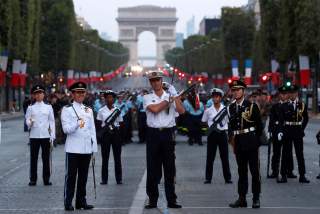Don't Underestimate Tiny Singapore's Military
It's military packs a punch.
Key Point: Singapore has invested heavily in western technology and hardware.
Despite its small geographical size, Singapore fields one of the most advanced and well-equipped militaries in South East Asia. It spends more on its military than any of its neighbors. Being a tiny city-state, one of the strongest arms of the Singaporean military is the Republic of Singapore Air Force. But how does it stack up against its neighbors, from the small to the big? Does Western tech really provide the level of advantage it needs to defend itself?
The backbone of the RSAF is a fleet of F-15 and F-16 fighters. The RSAF fields forty F-15SG Eagles, forty F-16Ds, and twenty F-16Cs. These are augmented by around thirty F-5S Tiger II and some A-4 Skyhawks in storage. Singapore also fields an AWACS capability with five Israeli modified Gulfstream 550 jets.
Out of all those aircraft, Singapore’s strongest fighter is definitely the F-15SG, itself a variant of the F-15E. The most important advantage the F-15SG has is the APG-63(V)3 AESA radar, which one of the best aircraft mounted radars on any fighter in the region.
AESAs also have the capability to perform electronic warfare (EW) tasks: they can actively degrade the lock of an active radar guided missile while scanning at the same time due to their electronic nature. The RSAF F-16s are also rumored to be undergoing similar upgrades to receive AESAs of their own.
The F-15SG also has an IRST system, which gives it the capability to detect and lock onto aircraft with infrared missiles without even switching on the radar. The IRST bulb is positioned on a pod pylon under the left engine of the F-15SG and is directly integrated into the plane.
To make the actual kill, the F-15SG wields the advanced AIM-9X Block II air-to-air missile. This is integrated with the Joint Helmet Mounted Cueing System helmet, which allows the seeker to track where the pilot is looking, allowing for the missile to lock onto targets off boresight.
While the Soviet Air Force pioneered this capability with the R-73 and Su-27/MiG-29 aircraft (including those fielded by its neighbors), the JHMCS and AIM-9X Block II take it to even further levels, with a wider seeker lock angle than what can be achieved with the Russian system.
For longer range targets, Singapore has access to advanced long-range active radar homing air-to-air missiles: the AIM-120C-7. It also has stocks of the medium-range AIM-120C-5. These can be fired from both the F-15 and F-16s Singapore has, although it’s likely the F-15 will be able to achieve a lock earlier on with its AESA radar.
While it’s clear Singapore’s Air Force packs a significant air-to-air punch, its mission is not to just protect Singapore itself but its interests in the immediate region. As a result, they have significant stocks of the AGM-154 JSOW, a long ranged American glide bomb that can fly up to 130km away. While these could be used to deliver an alpha strike against an opponent, Singapore is expected to use them more in an anti-shipping role.
One of Singapore’s greatest fighter threats might come from Indonesia, which bought the advanced Su-35S earlier this year. However, they are fewer in number than Singapore’s F-15SG fleet. Indonesia also fields many more different types of aircraft: the Indonesian Air Force has F-16s, original Su-27s, two different variants of the Su-30, and F-5E Tiger II s as well. Obviously, this results in greater maintenance and sustainment issues for Indonesia.
Another strong air force that could face Singapore is China’s PLAN aviation. China also has J-15 carrier fighters. These largely are Chinese-developed variants of the first-generation Su-27S Flankers China first received in the 1990s. While on paper they have the same capabilities as the F-15SG (ARH missiles, IRST, advanced radar), China’s Flankers are still considered to be underpowered due to their engines.
Malaysia also is a strong contender, fielding a weird mix of Western and Eastern planes like Indonesia. Unlike Indonesia, most of their Flankers are of older variants, and a good portion of their fighter fleet is relatively obsolete MiG-29s. They also do field the AIM-9X Block II like Singapore.
Overall, unlike their neighbors, Singapore has gone “all in” with Western tech. The common origins of their aircraft probably make resupply and maintenance easier. This trend looks to continue now that Singapore is looking into the F-35 as a replacement for their F-5Es. They also have the significant advantage of having AWACS aircraft, unlike their two closest neighbors.
Charlie Gao studied political and computer science at Grinnell College and is a frequent commentator on defense and national-security issues. This piece was originally featured in August 2018 and is being republished due to reader's interest.
Media: Reuters

